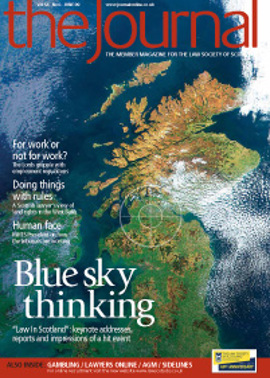Of chairs, trains and escalators

Lawyers are fond of looking for colourful or practical examples in order to illustrate convoluted legal points. Often, these bring with them their own dangers, particularly if the examples are selected in a way designed to illustrate the most extreme of possibilities. However, the decision of the House of Lords in Smith v Northamptonshire County Council [2009] UKHL 27 (20 May 2009) is probably the first (and almost certainly the last, given the imminent transfer of judicial authority to the new Supreme Court), major litigation in which a House of Lords committee room chair plays a potentially decisive role!
The background
Mrs Smith was a council driver. Among other things, she collected those in need of care from their homes and took them by minibus to a day centre. One such customer was a Mrs Cotter who was wheelchair-bound. To get Mrs Cotter out of her house to the transport, Mrs Smith took her down a wooden ramp leading from her livingroom to a patio. That ramp had been put in place about 10 years earlier by the NHS.
Mrs Smith had performed this task many times before without incident. As she was doing it on
1 December 2004, an edge of the ramp crumbled beneath her foot, causing her to stumble and sustain injury.
Mrs Smith sued the council, ultimately relying on the Provision & Use of Work Equipment Regulations 1998. At first instance, the judge held that the regulations applied because the ramp was work equipment being used at work. The Court of Appeal reversed that decision, holding that it was not such equipment.
On 20 May, by a 3-2 majority (Lord Carswell, Lord Mance and Lord Neuberger, Lord Hope and Baroness Hale dissenting) the House of Lords refused the appeal. As the regulations apply throughout the UK, the court’s decision on what Lord Hope described as “a question of general public importance” will be of significance in a wide variety of practical situations.
The challenges
It is apparent from even the swiftest canter through their Lordships’ speeches that all five members of the court found the matter particularly difficult. Each member delivered a detailed judgment (albeit of varying lengths). They clearly felt most acutely that the case forced them to face two conflicting policy issues. On the one hand, there was what might be thought to be the policy behind regulations such as those before the court, to promote health and safety, and the now popular phraseology,
“a health and safety culture”. On the other hand, as more claims push at the boundaries of what might be expected, there was a need to avoid the regulations producing results which were “excessively burdensome”.
Again, Mrs Smith was injured through no fault of her own. Her employers could insure against claims. The regulations imposed an absolute obligation where they applied. As Lord Hope pointed out, it was no defence to say that it was impossible to achieve the steps the regulations required, whether because there was a latent defect or because achievement was not reasonably practicable.
Against that, there was clearly no question of negligence. The ramp had not been provided by the council. It was not maintained by them, nor could it be. It had been provided by another statutory body. In some ways, it might have been regarded more as part of Mrs Cotter’s premises than anything else. There were other legal regimes which might apply.
Regulation 3(2)
As the arguments developed, the search for some limitation on employer liability focused ever more closely on the provisions of reg 3(2). That provides: “The requirements imposed by these regulations on an employer in respect of work equipment shall apply to such equipment provided for use or used by an employee at his work”.
It being conceded before their Lordships that the ramp was “work equipment”, attention turned to the phrase “used by an employee”. Various examples were presented of things being “used” where, it was suggested, it would be surprising if the regulations applied. A defective escalator in the London Underground was an example; a defective chair in the House of Lords committee room used by someone attending a hearing was another. Simply because it was work equipment which had been “used” was not enough to impose strict liability on the employer. Where should the boundaries lie?
The opinions
In the view of Lord Mance, a literal approach to the phrase “used at work” could not be correct. The solicitors’ firm requiring its clerk to attend the House of Lords hearing should not be strictly liable for injury caused by a defect in the committee room chair. In his view: “what matters is that some specific nexus (beyond the mere fact of use) is required between the equipment and the employer’s undertaking before the employer comes under the strict responsibilities imposed by the regulations”.
Lord Mance rejected a test of “control” which had been suggested by Lord Hope, and instead focused on the employer’s undertaking. He concluded that the test should be: “whether the work equipment has been provided or used in circumstances in which it was as between the employer and employee incorporated into and adopted as part of the employer’s business or other undertaking, whether as a result of being provided by the employer for use in it or as a result of being provided by anyone else and being used by the employee in it with the employer’s consent and endorsement”.
On that basis, Lord Mance concluded that the ramp was not incorporated into the council’s undertaking. They did not provide, own or possess it or have any responsibility, or indeed any right, to repair it. It was no more than “part of the environment” for the employee.
Lord Carswell, who effectively adopted the same approach, pointed out that it was desirable that the court should define the boundaries of liability in a way which was readily comprehensible by all those who have to operate the regulations, a range of persons which in his view extended well beyond personal injury lawyers. Whether the House has achieved that objective in the five speeches and 37 pages of this decision is at least open to debate.
Lord Neuberger (the third member of the majority) was clearly especially concerned with the risk that in an attempt to find a limit, the court might recast the legislative test, thus risking making matters worse rather than better. Nevertheless he felt that the provision had to be given some sort of limitation which was not expressed in the words of the regulation itself. Guidance ought therefore to be helpful in the majority of cases. In his view, the “control” test of Lord Hope and the “incorporation into undertaking” test of Lord Mance would normally lead to the same answer, albeit Lord Hope’s approach concentrated on the control over the employee’s use of the equipment (though the decree of potential inspection was relevant), whereas Lord Mance seemed to focus more on control over the equipment itself (though knowledge of the employee’s use was relevant). Ultimately, he preferred the view of Lord Mance.
Scope for argument
It is already clear that, notwithstanding the actual result in Smith, there is nothing in the judgments that will impose any major constraint on claims under the regulations in relation to events outwith what might be described as the traditional workplace. On any analysis of the formulations or tests discussed, it will be possible to argue a “specific nexus” between the offending item and the injured employee, particularly if the use of the item is regular. The phraseology of “consent and endorsement” will be said to be inferred or implied. Decisions may well tend to be very fact-specific. They are also subject to the possibility of different decision-makers reaching different decisions in precisely the same circumstances.
That is easily illustrated even in Smith. For instance, Lord Neuberger (who was with the majority in the result) pointed out that whatever formulation was adopted could be invoked to support the opposite result from that which it was said to justify. When he examined the test proposed by Lord Mance, it was arguable that “the council knew and effectively approved of Mrs Smith’s use of the ramp as the means of taking Mrs Cotter to and from her house, and, to that extent, it might be said that the ramp was incorporated into the council’s undertaking, at least when it was being so used by Mrs Smith”. In other words, the claim would succeed.
That Lord Neuberger went on to say that the point merely underlined the “substantial difficulties” facing those who have to interpret legislation such as the 1998 Regulations is not a great comfort.
He further indicated that the regulations were intended to “impose absolute liability on an employer in a very wide... range of factual circumstances”. Again, for him to say that that range was not “infinitely” wide will be little comfort to employers and insurers, while certainly not discouraging to those representing injured claimants.
Additional points
Two further points might usefully be made. First, the court, while noting that the council had in fact tested the ramp in the course of their normal risk assessment of premises, took the view that this gave no basis for liability (in the absence of negligence in that inspection, which was not made out). In fact, if anything, the court was anxious to dispel any suggestion that the council’s responsible behaviour of itself created a greater likelihood of liability.
Secondly, it is perhaps interesting to see one of the first major decisions issued by the court following the retirement of Lord Hoffmann, on reaching what Lord Mackay of Clashfern once memorably described as “the age of presumed judicial incompetence”, i.e. 75. It has been suggested elsewhere that Lord Hoffmann has dominated the House for some years. It was noticeable in the speeches in Smith that all of the judges referred back, in their search for assistance, to a previous discussion of similar issues by Lord Hoffmann (Spencer-Franks v Kellogg, Brown & Root [2008] UKHL 46). Clearly his legacy lives on.
In conclusion
Consideration of the judgments in Smith by subsequent courts will prove illuminating. It seems inherently unlikely that attempts to make employers liable in a variety of atypical circumstances will diminish. For the meantime, perhaps the best concluding comment is that a topic which finds all five judges in the Lords struggling to reach a conclusion is not one which the rest of the legal profession will find straightforward to advise on!
In this issue
- Spanish executry law – cross border issues
- The Scottish Parliament’s Emergency Bill procedure
- One year on
- Unequal before the law (1)
- Ian Smart's inauguration speech
- Your new First XI
- Dangerous loophole
- Unlocking the rule of law
- Our guiding light
- A hit for the conference
- Of chairs, trains and escalators
- Unequal before the law
- Matters of the mind
- New game, new rules
- Advance on all fronts
- Making openness work
- The First XI
- Society parleys with the OFT
- Professional Practice Committee
- Committees: the unsung heroes
- Find a client?
- Platform for success?
- Ask Ash
- Constant foe
- Killer question
- A time to be inventive
- Deep pockets required?
- Win some, lose some
- New client - new problems
- Website review
- Book reviews
- A business view






